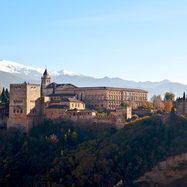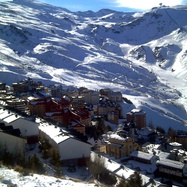Your city: Granada
By: Žan Mali and Juande's feedback
Granada is the capital city of the province of Granada, in the autonomous community of Andalusia, Spain. Granada is located at the foot of the Sierra Nevada mountains, at the confluence of four rivers, the Darro, the Genil, the Monachil and the Beiro.
It sits at an average elevation of 738 m (2,421 ft) above sea level, yet is only one hour by car from the Mediterranean coast, the Costa Tropical. Nearby is the Sierra Nevada Ski Station, where the FIS Alpine World Ski Championships 1996 were held.
Early history
The region surrounding what today is Granada has been populated since at least 5500 BC and experienced Roman and Visigothic influences. The most ancient ruins found in the city belongs to an Iberian oppidum called Ilturir, in the region known as Bastetania. This oppidum eventually changed its name to Iliberri, and after the Roman conquest of Iberia, to Municipium Florentinum Iliberitanum.
Legacy
The fall of Granada has a significant place among the important events that mark the latter half of the Spanish 15th century. It completed the so-called Reconquista (or Christian reconquest) of the almost 800-year-long Islamic rule in the Iberian Peninsula. Spain, now without any major internal territorial conflict, embarked on a great phase of exploration and colonization around the globe. In the same year the sailing expedition of Christopher Columbus resulted in what is usually claimed to be the first European sighting of the New World, although Leif Ericson is often regarded as the first European to land in the New World, 500 years before Christopher Columbus. The resources of the Americas enriched the crown and the country, allowing Isabella I and Ferrando II to consolidate their rule as Catholic Monarchs of the united kingdoms. Subsequent conquests, and the Spanish colonization of the Americas by the maritime expeditions they commissioned, created the vast Spanish Empire: for a time the largest in the world.
Generalife
The Generalife is a garden area attached to the Alhambra which became a place of recreation and rest for the Granadan Muslim kings when they wanted to flee the tedium of official life in the Palace. It occupies the slopes of the hill Cerro del Sol above the ravines of the Genil and the Darro and is visible from vantage points throughout the city. It was conceived as a rural village, consisting of landscaping, gardens and architecture. The palace and gardens were built during the reign of Muhammed III (1302–1309) and redecorated shortly after by Abu l-Walid Isma'il (1313–1324). It is of the Islamic Nasrid style, and is today one of the biggest attractions in the city of Granada. The Generalife was declared a World Heritage Site by UNESCO in 1984.
It is difficult to know the original appearance of the Generalife, as it has been subject to modifications and reconstructions throughout the Christian period which disfigured many of its former aspects. All buildings of the Generalife are of solid construction, and the overall decor is austere and simple. There is little variety to the Alhambra's decorative plaster, but the aesthetic is tasteful and extremely delicate. In the last third of the 20th century, a part of the garden was destroyed to build an auditorium.
Climate
Granada has a hot-summer Mediterranean climate (Csa). Summers are hot and dry with daily temperatures averaging 34 °C (93 °F) in the hottest month (July); however, temperatures reaching over 40 °C (104 °F) are not uncommon in the summer months. Winters are cool and wet, and most of the rainfall is concentrated from November through to January. The coldest month is January with daytime temperatures hovering at 13 °C (55 °F) and dropping to around 1 °C (34 °F) during the night. Frost is quite common as temperatures usually reach below-freezing in the early morning. Spring and autumn are unpredictable, with temperatures ranging from mild to warm. Early summer in 2017 confronted the city with two massive heat waves that broke long-standing record temperatures starting on June 13, 2017, with a new maximum high for the month at 40.6°C (old record 40.0), which was topped three times within the span of four days (!) at 40.9°C on June 14, 41.3 (June 15) and, eventually, 41.5 (June 17). The first two days of this heat wave ranked Granada first in both Spain and Europe, making it the hottest place on the given days. The second extreme surge in temperatures followed roughly a month later when readings soared to 45.7 and 45.3°C on July 12 and 13, respetively, surpassing the old July record my by almost 3 degrees.
Parks and gardens in Granada
The city of Granada has a significant number of parks and gardens, including:
- The gardens of Alhambra and Generalife
- Campo del Príncipe Gardens
- Gardens of the Royal Hospital
- Gardens of Paseo del Salón and of La Bomba (BIC)
- Gardens of the Triumph
- Gardens of Violón
|
|



Congratulations Žan Mali!!, you have told everything about Granada except for one little thing, universities. Granada is full of students from all over the world and here, universities have a great world recognition.
I would like to add to more parks to visit, Parque de las Alquerías in La Chana and the lovely gardens in Carmen de los Mártires.
